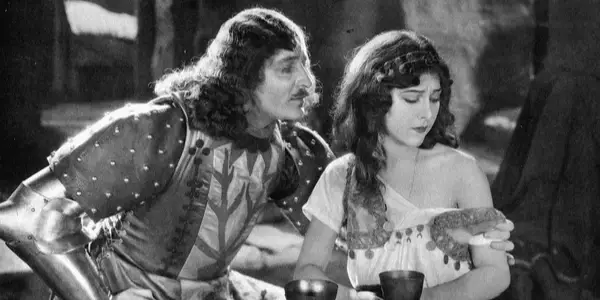
Welcome to A Century in Cinema, the monthly column where I’ll be discussing films from a hundred years ago, the historical impact they had, and how they hold up today. Whether we’re covering timeless classics or obscure gems, follow along as we continue to explore…a century in cinema! WARNING: Hundred-Year-Old SPOILERS ahead!
“All Quasimodo knew was that this girl had once been kind to him.”
In the spirit of openness, I must confess, this has been the film I’ve most looked forward to from this year. To be fair, it’s the only one I’ve seen prior to writing this column, and Disney’s 1996 version is admittedly my favorite Disney film. I’m also a big fan of the book by Victor Hugo, and given my lifelong love of Universal monster movies, my adoration for Lon Chaney should be no surprise. So many facets of my life intersect with this film, 1923’s The Hunchback of Notre Dame, and I have been looking forward to sharing it with both silent film buffs for whom this might ring a bell (not sorry) and potential new fans alike.
A Tale of Love, Loneliness, and Class Warfare
The film opens on the Festival of Fools, a day of hedonistic revelry for the common man (though it has been argued that the holiday was much more pious than is currently believed) and release from the tyranny of King Louis XI. As Parisians party, they are eyed by the titular hunchback, Quasimodo (Chaney), deaf and half-blind, who openly mocks and jeers at passersby and even climbs down the face of the cathedral to ensure they can see that their disdain for him is indeed reciprocated. As the festivities continue, Clopin (Ernest Torrence), the King of the Beggars, has his adopted daughter Esmeralda (Patsy Ruth Miller) dance for the crowd. In doing so, she catches the eye of Quasimodo, Jehan (Brandon Hurst), the wicked brother of Notre-Dame’s archdeacon Dom Claude (Nigel De Brulier), and the newly-appointed Captain of the Guard Phoebus de Chateaupers (Norman Kerry), who eschews his fiancée for an attempt to woo Esmeralda.
source: Universal Pictures
That night, Jehan forces Quasimodo to accompany him and attempt to kidnap Esmeralda. She’s rescued by Phoebus and his men as Jehan slinks into the shadows and leaves Quasimodo to fend for himself. Viewing Phoebus as her knight in shining armor, she’s immediately smitten and agrees to dine with him. While she sees him as the man of her dreams, he only sees her as his woman for the evening, a point driven home by cutting to a shot of a spider approaching a butterfly caught in its web. Meanwhile, Pierre Gringoire (Raymond Hatton), a street poet, accidentally finds himself in the Court of Miracles, a haven for Clopin and his less-than-reputable ilk. The crowd calls for him to be hanged, but Esmeralda steps in just in time. Quasimodo is brought in front of a judge and sentenced to a public lashing. “Again was a slave to suffer for his master’s crime.” After being tied to a wheel in the cathedral square, he’s whipped to the delight of the crowd. He calls out for water, but he’s ignored by all except Esmeralda who’s once again the embodiment of morality and kindness. Dom Claude, realizing what has happened, approaches and unties him.
Later, a ball is thrown to celebrate Phoebus’ promotion, who has convinced Esmeralda to accompany him and even provides her with new attire for the evening. Clopin learns of her whereabouts and rallies a party to “rescue” her as she’s introduced by Phoebus to the host of the ball as an Egyptian princess. Clopin and his mob force their way in and he confronts Phoebus, who proclaims his love for her. However, she steps in, admitting her place is with her people and she doesn’t belong there, and dishonestly claims to not love him. She leaves with Clopin, who promises a day when nobles will no longer trample over commoners like them.
source: Universal Pictures
Some time after, Phoebus continues to pine after Esmeralda, who sends him a note via Gringoire to meet her at Notre-Dame for a final farewell. Such a message revives his spirits, while Clopin becomes concerned with Esmeralda’s growing interest in being wed. Jehan approaches him with an offer: half of Notre-Dame’s treasure for Esmeralda’s hand. Though intrigued, he declines. That night, as Esmeralda enters the cathedral, she’s overcome by its beauty as Phoebus awaits her. She gives a tearful goodbye as Quasimodo comes upon them. Phoebus is cruel to him, and a crestfallen Quasi shuffles away. Jehan spies the couple from the balcony above and follows them. As they enter the garden, Phoebus continues to proclaim his adoration for her as Jehan stabs him in the back and flees. She cries for help, but the men who arrive at the scene believe her to be his attacker. She must answer to the court as well, feverishly denying any involvement, as Jehan smirks from the corner. She accuses him, which he easily deflects by claiming she’s bewitched. She’s taken away to be put to “the question,” or rather a forced confession by torture. She continues to insist her love, but one turn of the vice and she agrees to confess to anything they wish.
While Phoebus is bedridden, Jehan visits to inquire about his health and informs him that Esmeralda is to be hanged. Clopin later visits the cathedral to find the archdeacon and Quasimodo in prayer and asks for Esmeralda, only to learn she’s been arrested. He mocks Dom Claude and his faith, which causes Quasimodo to attempt to defend his honor. Clopin swears to find her, even if he has to tear down the whole church. He leaves as Dom Claude leads Quasimodo away, preventing any further violence.
source: Universal Pictures
While in prison, Esmeralda is visited by Jehan in disguise. He begs her to follow him out, but she insists she’d rather die. Jehan tells her that Phoebus died the night before, and he had promised to save her, professing his love for her as well. She refuses, deeming him an assassin, and he leaves her to hang. Suddenly, her execution is expedited and Quasimodo rings the bells, not knowing it was her death knell. As everyone gathered to watch the hanging, including men working on the cathedral, Quasimodo also looks out to realize who is being sentenced. As she’s forced to kneel on the steps and give penance, he slides down a rope and carries her inside to provide her with sanctuary. Dom Claude keeps the guards at bay, ordering them to respect this sacred law. Lurking outside, Jehan spies the room she occupies with Quasi and Dom Claude, who will provide shelter until her appeal.
“Long enough the aristocrats have treated us as sheep. We’ll show them – we are wolves.”
Meanwhile, Clopin and his men plan to rescue Esmeralda on her way to the gallows. Always lying to someone, Jehan informs Clopin that her execution is set for that very day. Immediately, Clopin calls the Court to arms, and all follow him to Notre-Dame to sack the city. Soon, all the hidden corners of Paris are abuzz with the news, and more and more people flock to join the cause and overturn the status quo of the city. Gringoire rushes to Phoebus, physically healed but emotionally wounded, and informs him of Esmeralda’s true status, alive within Notre-Dame and Clopin on the way. Phoebus dons his armor and calls for troops as he rushes to the church. From within, Esmeralda is shocked at the crowd charging toward the doors with torches and weapons. She rouses Quasimodo as the doors are being chipped away and fires are started in the courtyard. Seeing the crowd below and determined to protect both of his ladies, he furiously throws bricks, beams and anything else at the rabble below. Though it takes out some of their compatriots, Clopin leads some men to use the beam as a battering ram for the doors as the guards ride closer. Incensed, Quasimodo dumps cauldrons of molten lead through the gutters as a fiery baptism while Esmeraldo helplessly watches him cackle with glee at the violence and death he inflicts to defend his loves.
As the guards arrive on the scene, a full-scale battle erupts. Quasimodo applauds and cheers on the carnage while Jehan sneaks around and grabs Esmeralda. She fights back, certain God will protect her. Noticing she’s gone, Quasimodo finds her with Jehan, his betrayer. He grabs Jehan, who stabs him in the back – literally this time – as Quasi throws him over the railing, then collapses in pain just as Phoebus enters to save Esmeralda. From the balcony, Quasimodo watches them. He struggles to walk away as Gringoire and Dom Claude enter to find the happy couple, then hear the bell ring. In the tower, Quasimodo rings his own death knell, before dying as the two enter, with the bell swinging over him one last time.
A Platinum-Tier Production
Known as Universal’s “Super Jewel” of 1923, it was a smash hit, grossing $1.5 million domestically, and $3.5 million globally. It was their most successful silent film, tying Safety Last! for the third-highest-grossing film of the year, influencing Carl Laemmle to do another “prestige picture” based on Victor Hugo’s work: The Man Who Laughs (1928). It was Lon Chaney’s most expensive film, and catapulted him to full-star status. His now-iconic makeup (one of many) took about three hours to apply, which included a false eye and teeth, putty for his cheeks and nose, and a plaster hump that weighed 10-15 pounds. He also used a brace for his legs that reportedly caused him chronic pain for the rest of his life. Despite that, Chaney’s exaggerated actions, particularly as he leaps to yank the rope to ring the bells, give an already-dynamic character even more energy. A legend of silent film, every gesture, every move that he makes tells a story more than any title card.
source: Universal Pictures
The film’s production was predictably massive, with a set spanning nineteen acres and requiring Universal to build a larger wardrobe building in order to dress the over two-thousand extras in period clothing. In total there were approximately 750 crew members, with a staggering 105 electricians alone. Having acquired the rights to the story in 1921, Chaney was heavily involved in the development and production, including the selection of Wallace Worsley as director, who he had previously worked with on four films, and working closely with Patsy Ruth Miller to develop her character. The Hunchback of Notre Dame was also reportedly the first film to use an intercom system on set for the director to communicate throughout filming.
Conclusion
For all the immense cost and effort, it paid off, leaving the studio with a huge success that is still enjoyable to this day. While it might not be as faithful to the source material as other adaptations (and it is odd seeing Claude Frollo as a good guy in any version), its influence on future productions can clearly be seen, from certain scenes and actions to even specific shots, such as when Quasimodo bursts through the door to find Esmeralda and Jehan. The script by Perley Poore Sheehan and Edward T. Lowe Jr. does a great job of balancing so many characters and their respective arcs, on par with modern historical dramas.
Interestingly, the version of this film on Prime Video as of this writing – while still a predominantly silent picture – not only has a score added to it, but also some crucial sound effects at certain moments, such as the ringing of the bells or the cheering of the crowd. For viewers curious about the film, but not big on silent pictures, that may be a good way to ease into them. This iteration of The Hunchback of Notre Dame is a must for Chaney fans, Hugo Stans, or anyone who’s seen the Disney film and is looking for something a little more true in tone to the book, though the 1939 version is considered to be the most faithful adaptation. Put this on your list today.
Does content like this matter to you?
Become a Member and support film journalism. Unlock access to all of Film Inquiry`s great articles. Join a community of like-minded readers who are passionate about cinema – get access to our private members Network, give back to independent filmmakers, and more.





